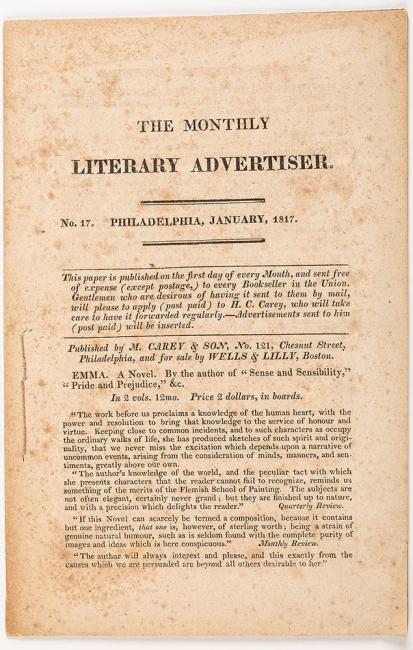Listen to co-curator Juliette Wells discuss Jane Austen’s first publication in North America.

MARKETING EMMA IN THE USA
After emigrating from Dublin in 1784, Mathew Carey (1760–1839) became a leading publisher in the young United States. In addition to printing works by American authors, he produced unauthorized reprints of books published in London and elsewhere. This was an entirely legal endeavor, however, as international copyright law did not yet exist. Carey’s edition of Emma sold for $2 in boards (publisher’s binding), half the price of copies imported from London. This advertisement for Emma, prominently placed on the first page of the catalogue Carey sent to booksellers in other cities, includes positive reviews from Britain. The uncredited Quarterly Review blurb was written by Walter Scott.
The Monthly Literary Advertiser, no. 17
Philadelphia: January 1817
American Antiquarian Society, Worcester, Massachusetts
It was long unknown why Mathew Carey reprinted Emma rather than another Austen novel, as well as how many copies he issued and when exactly in 1816 his edition reached the market. My research has revealed that Carey received a copy of Emma in April 1816 as part of a shipment of works newly published in London. In the summer of that year, Carey charged the Trenton, New Jersey firm of Justice & Cox with printing the novel. The process was protracted, in part because Carey had difficulty sourcing enough American-made paper to supply Justice & Cox with what they needed. Carey’s business records show that he issued a 500-copy edition of Emma in the last weeks of December, 1816. He distributed copies to Wells & Lilly, the bookseller in Boston acknowledged on the novel’s title page, as well as to booksellers in other American cities. The edition did not sell rapidly and did not sell out. As a result, Carey did not reprint any other novel by this author, whose name, of course, he did not know.
Americans who saw this Emma in a bookstore would have known, from its title page, that it was an unauthorized reprint, thanks to the phrase “three volumes in two.” Paper, which was handmade, was the single largest expense in book publishing at the time. By having his printers use narrow margins, a small font, and tightly spaced lines of text, Carey was able to economize substantially.
